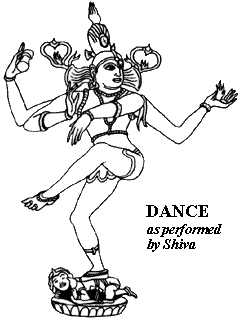
DANCING
Dancing has been an important component of many religious rituals. Repetitive rhythmical movement was thought essential to build up to the moment of ecstatic union with the deity.
Dancing is a gesture of the whole body which can ally the body with the soul. It is one of the most powerful forms of spiritual or magical ritual. It is a dynamic tool for awakening and stirring the subtle forces and energies of life. True sacred dance is a means of focusing and directing consciousness through physical behavior. It is an outer expression of the inner spirit.
Ancient worshipers of the Goddess attributed the initial creation of the universe to her magic dance over the Waters of Chaos, or the Great Deep (Hebrew Tehom). With rhythmic movements she organized the as-yet-unformed elements, making orderly patterns that the Greeks called diakosmos, the "Goddess's Ordering". She is still found even in the Bible, as the spirit that "moved" on the face of the Deep before God spoke the universe into being.
The four-armed Shiva is worshipped as a world-sustaining deity whose cosmic dance (nataraj) expresses the symbolic movements of the universe and the rhythms of ongoing existence.
In the Gnostic gospel Acts of John, even Jesus danced and said to his disciples, "To the Universe belongs the dancer. He who does not dance does not know what happens." Early Christian churches carried on liturgical dancing in imitation of all their pagan contemporaries; but a wave of asceticism about the sixth or seventh century outlawed ecclasiastical dancing on the ground that it was too sensual and too much enjoyed by women. Though dance is not regularly practiced in modern Christianity, the bible says (Psalm 150, v 4) to "Praise him with the timbrel and dance."
The ab was one of the Egyptian's seven souls that was supposed to come directly from the mother's heart, in the form of holy lunar blood that descended into her womb to take the shape of her child. The hieroglyphic sign for this eminently matriarchal idea was a dancing figure, representing the inner dance of life perceived in the heartbeat. As long as the dance continues, life goes on.
Dancing is a gesture of the whole body which can ally the body with the soul. It is one of the most powerful forms of spiritual or magical ritual. It is a dynamic tool for awakening and stirring the subtle forces and energies of life. True sacred dance is a means of focusing and directing consciousness through physical behavior. It is an outer expression of the inner spirit.
Ancient worshipers of the Goddess attributed the initial creation of the universe to her magic dance over the Waters of Chaos, or the Great Deep (Hebrew Tehom). With rhythmic movements she organized the as-yet-unformed elements, making orderly patterns that the Greeks called diakosmos, the "Goddess's Ordering". She is still found even in the Bible, as the spirit that "moved" on the face of the Deep before God spoke the universe into being.
The four-armed Shiva is worshipped as a world-sustaining deity whose cosmic dance (nataraj) expresses the symbolic movements of the universe and the rhythms of ongoing existence.
In the Gnostic gospel Acts of John, even Jesus danced and said to his disciples, "To the Universe belongs the dancer. He who does not dance does not know what happens." Early Christian churches carried on liturgical dancing in imitation of all their pagan contemporaries; but a wave of asceticism about the sixth or seventh century outlawed ecclasiastical dancing on the ground that it was too sensual and too much enjoyed by women. Though dance is not regularly practiced in modern Christianity, the bible says (Psalm 150, v 4) to "Praise him with the timbrel and dance."
The ab was one of the Egyptian's seven souls that was supposed to come directly from the mother's heart, in the form of holy lunar blood that descended into her womb to take the shape of her child. The hieroglyphic sign for this eminently matriarchal idea was a dancing figure, representing the inner dance of life perceived in the heartbeat. As long as the dance continues, life goes on.
Dance, when you're broken up.
Dance, if you've torn the bandage off.
Dance in the middle of the fighting.
Dance in your blood.
Dance, when you're perfectly free.
-- rumi --
Dance, if you've torn the bandage off.
Dance in the middle of the fighting.
Dance in your blood.
Dance, when you're perfectly free.
-- rumi --
RELATED VAULTS #
WHIRLING DERVISHES #
MEDIA COVERAGE #
Study shows hard drugs link to the rave scene, The Scotsman (UK)
OFF-SITE RESOURCES
RAVING #
The Official alt.raves FAQ (1994)
Trance Dancing - The Rave by by Jason Keehn
Can Trance Dancing Save the Planet? by Jason Keehn
Trance Magick by Kath
FREESTYLE EXPRESSION #
ISLAM / SUFI #
NATIVE AMERICAN #
Native American Dance (general)
CHRISTIAN #
PAGAN / WICCAN #
Drumming and Dancing by Morgan Léy
ORGANIZATIONS #
ARTICLES & WRITINGS #
Sacred Dance and Spirituality by Lynn Frances
Trance Dancing with Shiva Nataraj by Nikki Lastreto
Alternative Worship Styles Draw Younger Crowds by Donald E. Skinner
The World's Oldest Dance (belly dance) by The Joyful Dancer
A Lecture on Eurythmy by Rudolf Steiner
HEALTH #
Dancing Wards Off Dementia, BBC News, June 2003
(Verghese 2003)
BOOKS #
Sweat Your Prayers by Gabrielle Roth
Dancing for Joy by Murray Silberling
Sacred Woman, Sacred Dance by Iris J. Stewart
Tibetan Sacred Dance by Ellen Pearlman


